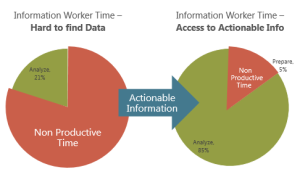Data Management and Your Team
I presented a lunch and learn called, “SharePoint and Upstream” to a group of fifteen people last week at III Forks. Over the next few blog posts, I plan to go into more depth for some of the key points that we covered. This week, I will specifically cover how data management issues are probably wasting your employee’s time.
Last week in his blog post, our director of consulting, Chad, discussed how a lack of business intelligence causes the average employee to waste almost two hours every day hunting for information. If we scale the absence of business intelligence a notch back to its base, data, we find even more area for concern.
Where Time is Spent on Data
One Schlumberger study shares some interesting points about what happens when data is not available to employees. Lack of data availability generally means that there is no central repository. The data is often lacking meta data that would make individual pieces easier to find, and it probably isn’t searchable or browsable.
According to the study, in this situation, people spend more than half of their time just identifying the information they need.
They also spend 25% of their time preparing data for analysis, which leaves only about 20% of their time for actually analyzing data. Data analysis is where humans add value to the decision making process, because computers cannot make decisions.
Decision Making Should Be the Focus
Since data isn’t valuable until it has been analyzed, it seems obvious that the focus should be on enabling people to skip as much of the identification and preparation work as possible.
 The process of translating data into something useful is what we call actionable information. In other words, information that is close possible to being ready for consumption when decision maker gets to it.
The process of translating data into something useful is what we call actionable information. In other words, information that is close possible to being ready for consumption when decision maker gets to it.
The illustration to the left is a good representation of what happens when we take raw data and present it as actionable information.
Whereas almost 80% of an employee’s time was spent doing non-productive tasks in the absence of information, access to actionable information reduces that non-productive time to 15% or less.
Strategies for Bringing Data to the Forefront
There can be a gap between knowing that actionable intelligence makes employees more productive and actually implementing it. These three strategies can be a good starting place for your company:
Data cubes process the data you need quickly and efficiently. They are one option for removing the preparation burden mentioned earlier.
It’s easy to assume that if a little data is good, a lot is better. Without a data management strategy, however, too much data is overwhelming and presents a similar barrier to decision making as not enough.
3. Becoming a good data consumer
Once data is available for consumption, it is important to have the skills to interpret that data and use it to make good decisions. The Harvard Business Journal shared three tips for getting started.
Acting on the numbers
Being aware of areas where your company is losing money as a result of wasted time and bad decisions is the first step to fixing the problem. The investment is well worth your company’s money when it leads to increased time spent in value creation!
To listen to the complete podcast “SharePoint for Upstream,” click here, or check out the rest of our blog series on how improving SharePoint can help your company.
